| Partial eclipse | |||||||||||||
| Date | July 15, 1916 | ||||||||||||
|---|---|---|---|---|---|---|---|---|---|---|---|---|---|
| Gamma | -0.5956 | ||||||||||||
| Magnitude | 0.7944 | ||||||||||||
| Saros cycle | 118 (46 of 74) | ||||||||||||
| Partiality | 172 minutes, 30 seconds | ||||||||||||
| Penumbral | 292 minutes, 24 seconds | ||||||||||||
| |||||||||||||
A partial lunar eclipse took place on Saturday, July 15, 1916. The moon was strikingly shadowed in this deep partial eclipse which lasted 2 hours and 53 minutes, with 79% of the moon in darkness at maximum.
The Ross Sea party was a component of Sir Ernest Shackleton's Imperial Trans-Antarctic Expedition of 1914–17. Five men were stranded not far away from Cape Evans. There was sea ice between them and the relative safety of the hut on Cape Evans. On May 8 two of the men, Aeneas Mackintosh and Victor Hayward, decided to make an attempt to reach the hut. Soon after they set out, a blizzard hit. When the weather cleared up, the remaining men tried to look for them, but realized that the ice was far too thin to cross, and that their friends had been lost. Now they knew that they should wait for a thicker ice and for the full moon to attempt the crossing. Having the full moon was essential, because during polar night the moon is the only source of natural light other than the extremely dim light of the stars.
The weather did not cooperate during the full moon of June, but on July 15, everything seemed to be just right: calm weather, thick ice, clear skies and a full moon. The men started their journey in the morning. When the moon rose, however, the men were surprised to find it was about to be eclipsed[ citation needed ]. Ernest Wild wrote later:
"I thought we were going to be left in darkness but a very little bit of the rim remained to light us..."
Although the eclipse continued for a few hours, the men were fortunate because it was only a partial eclipse. They reached Cape Evans later on the same day. [1]
| Descending node | Ascending node | |||||
|---|---|---|---|---|---|---|
| Saros | Date Viewing | Type Chart | Saros | Date Viewing | Type Chart | |
| 103 | 1915 Jan 31  | Penumbral | 108 | 1915 Jul 26  | Penumbral | |
| 113 | 1916 Jan 20  | Partial | 118 | 1916 Jul 15 | Partial | |
| 123 | 1917 Jan 08  | Total | 128 | 1917 Jul 04  | Total | |
| 133 | 1917 Dec 28  | Total | 138 | 1918 Jun 24  | Partial | |
| 143 | 1918 Dec 17  | Penumbral | ||||
A lunar eclipse will be preceded and followed by solar eclipses by 9 years and 5.5 days (a half saros). [2] This lunar eclipse is related to two annular solar eclipses of Solar Saros 125.
| July 10, 1907 | July 20, 1925 |
|---|---|
 |  |
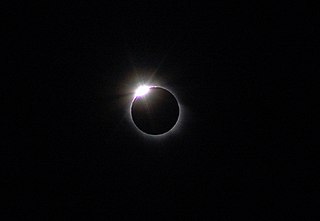
A total solar eclipse occurred on March 29, 2006. A solar eclipse occurs when the Moon passes between Earth and the Sun, thereby totally or partly obscuring the image of the Sun for a viewer on Earth. A total solar eclipse occurs when the Moon's apparent diameter is larger than the Sun's, blocking all direct sunlight, turning day into darkness. Totality occurs in a narrow path across Earth's surface, with the partial solar eclipse visible over a surrounding region thousands of kilometres wide. It was visible from a narrow corridor which traversed half the Earth. The magnitude, that is, the ratio between the apparent sizes of the Moon and that of the Sun, was 1.052, and it was part of Saros 139.
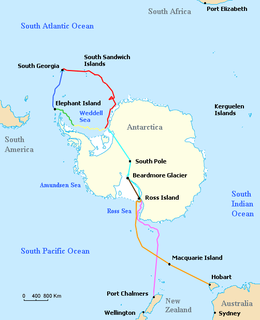
The Ross Sea party was a component of Sir Ernest Shackleton's 1914–1917 Imperial Trans-Antarctic Expedition. Its task was to lay a series of supply depots across the Great Ice Barrier from the Ross Sea to the Beardmore Glacier, along the polar route established by earlier Antarctic expeditions. The expedition's main party, under Shackleton, was to land near Vahsel Bay on the Weddell Sea on the opposite coast of Antarctica, and to march across the continent via the South Pole to the Ross Sea. As the main party would be unable to carry sufficient fuel and supplies for the whole distance, their survival depended on the Ross Sea party setting up supply depots, which would cover the final quarter of their journey.
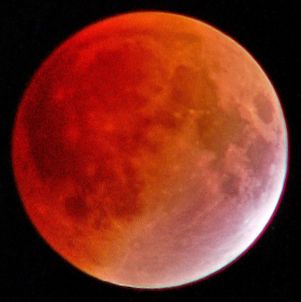
A total lunar eclipse occurred on 28 August 2007, lasting just over 90 minutes. The Moon entered the Earth's penumbra at 7:53:40 UTC. The first partial phase began in earnest at 8:51:16 UTC when the Moon entered the Earth's umbra. It exited the penumbra at 13:20:57 UTC.

Aeneas Lionel Acton Mackintosh was a British Merchant Navy officer and Antarctic explorer, who commanded the Ross Sea party as part of Sir Ernest Shackleton's Imperial Trans-Antarctic Expedition, 1914–1917. The Ross Sea party's mission was to support Shackleton's proposed transcontinental march by laying supply depots along the latter stages of the march's intended route. In the face of persistent setbacks and practical difficulties, Mackintosh's party fulfilled its task, although he and two others died in the course of their duties.

Ernest Edward Mills Joyce AM was a Royal Naval seaman and explorer who participated in four Antarctic expeditions during the Heroic Age of Antarctic Exploration, in the early 20th century. He served under both Robert Falcon Scott and Ernest Shackleton. As a member of the Ross Sea party in Shackleton's Imperial Trans-Antarctic Expedition, Joyce earned an Albert Medal for his actions in bringing the stricken party to safety, after a traumatic journey on the Great Ice Barrier. He was awarded the Polar Medal with four bars, one of only two men to be so honoured, the other being his contemporary, Frank Wild.

Arnold Patrick Spencer-Smith was an English clergyman and amateur photographer who joined Sir Ernest Shackleton's 1914–1917 Imperial Trans-Antarctic Expedition as chaplain on the Ross Sea party, who were tasked with laying a chain of depots across the Ross Ice Shelf towards the Beardmore Glacier for Shackleton's intended crossing party.

The drift of the Antarctic exploration vessel SY Aurora was an ordeal which lasted 312 days, affecting the Ross Sea party of Sir Ernest Shackleton's Imperial Trans-Antarctic Expedition, 1914–1917. It began when the ship broke loose from its anchorage in McMurdo Sound in May 1915, during a gale. Caught in heavy pack ice and unable to manoeuvre, Aurora, with eighteen men aboard, was carried into the open waters of the Ross Sea and Southern Ocean, leaving ten men stranded ashore with meagre provisions.

Commander Joseph Russell Stenhouse, DSO, OBE, DSC, RD, RNR (1887–1941) was a Scottish-born seaman, Royal Navy Officer and Antarctic navigator, who commanded the expedition vessel SY Aurora during her 283-day drift in the ice while on service with the Ross Sea Party component of Sir Ernest Shackleton's Imperial Trans-Antarctic Expedition in 1914–17. After Aurora's escape from the ice he brought her safely to New Zealand, but was thereafter replaced as the vessel's commander. He later served with distinction in the Royal Navy during both World Wars.

A total lunar eclipse took place on 10 December 2011. It was the second of two total lunar eclipses in 2011, the first having occurred on June 15. A lunar eclipse occurs when the moon is positioned just right in its orbit to pass through Earth's shadow.

The partial lunar eclipse of 26 June 2010 was the first of two lunar eclipses in 2010. At maximum eclipse, 54.2% of the moon was covered by the earth's shadow.
Victor George Hayward was a London-born accounts clerk whose taste for adventure took him to Antarctica as a member of Sir Ernest Shackleton's Imperial Trans-Antarctic Expedition, 1914–17. He had previously spent time working on a ranch in northern Canada and this experience, combined with his "do-anything" attitude, was sufficient for him to be engaged by Shackleton as a general assistant to the Ross Sea party, a support group with a mission to lay depots for the main cross-continental party.

A total lunar eclipse occurred on 31 January 2018. The Moon was near its perigee on 30 January and as such may be described as a "supermoon", when the Moon's distance from the Earth is less than 360,000 km. The previous supermoon lunar eclipse was in September 2015.

A total lunar eclipse occurred on 26 May 2021. A lunar eclipse occurs when the Moon moves into the Earth's shadow. This can occur only when the Sun, Earth, and Moon are exactly or very closely aligned with Earth between the other two, which can only happen at a full moon. The eclipsed moon appeared as a faint red disk in the sky due to a small amount of light being refracted through the earth's atmosphere; this appearance gives a lunar eclipse its nickname of a Blood Moon.
An annular solar eclipse occurred at the Moon's ascending node of the orbit on January 15, 2010, with a magnitude of 0.91903. A solar eclipse occurs when the Moon passes between Earth and the Sun, thereby totally or partly obscuring the image of the Sun for a viewer on Earth. An annular solar eclipse occurs when the Moon's apparent diameter is smaller than the Sun's, blocking most of the Sun's light and causing the Sun to look like an annulus (ring). An annular eclipse appears as a partial eclipse over a region of the Earth thousands of kilometres wide. It was the longest annular solar eclipse of the millennium, and the longest until December 23, 3043, with the length of maximum eclipse of 11 minutes, 7.8 seconds, and the longest duration of 11 minutes, 10.7 seconds. This is about 4 minutes longer than total solar eclipses could ever get.
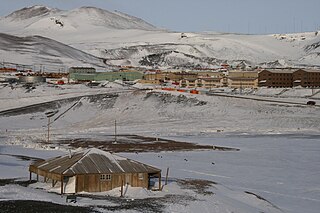
Discovery Hut was built by Robert Falcon Scott during the Discovery Expedition of 1901–1904 in 1902 and is located at Hut Point on Ross Island by McMurdo Sound, Antarctica. Visitors to Antarctica, arriving at either the US Base at McMurdo or New Zealand's Scott Base are likely to encounter Discovery Hut as both are located on Hut Point. Discovery Hut is just 300m from McMurdo Base. The hut has been designated a Historic Site or Monument, following a proposal by New Zealand and the United Kingdom to the Antarctic Treaty Consultative Meeting.

A partial solar eclipse occurred on June 1, 2011. A solar eclipse occurs when the Moon passes between Earth and the Sun, thereby totally or partly obscuring the image of the Sun for a viewer on Earth. A partial solar eclipse occurs in the polar regions of the Earth when the center of the Moon's shadow misses the Earth.

A partial solar eclipse occurred on July 1, 2011. A solar eclipse occurs when the Moon passes between Earth and the Sun, thereby totally or partly obscuring the image of the Sun for a viewer on Earth. A partial solar eclipse occurs in the polar regions of the Earth when the center of the Moon's shadow misses the Earth. This is the first solar eclipse of Saros series 156, only visible as a partial solar eclipse in a small area south of South Africa and north of Antarctica. At greatest eclipse, the magnitude was just 0.097. It is the first new saros series to begin since saros 155 began with the partial solar eclipse of June 17, 1928. The eclipse belonged to Saros 156 and was number 1 of 69 eclipses in the series. Thus, the 2011 Jul 01 event was the first eclipse of the series.

A partial solar eclipse took place on February 15, 2018. A solar eclipse occurs when the Moon passes between Earth and the Sun, thereby totally or partly obscuring the image of the Sun for a viewer on Earth. A partial solar eclipse occurs in the polar regions of the Earth when the center of the Moon's shadow misses the Earth.
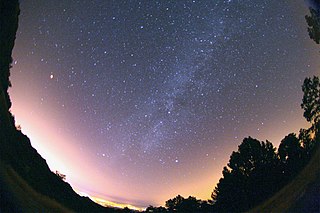
Historically significant lunar eclipses are eclipses of the Moon that are mentioned in historical accounts in connection with a significant event. Lunar eclipses are somewhat rare events, although not as rare as solar eclipses, because unlike solar eclipses they can be viewed from anywhere on the dark side of the Earth. Throughout history lunar eclipses have been held to be responsible for lost battles, and have helped make possible extraordinary escapes.
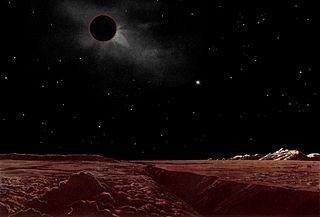
Solar eclipses on the Moon are caused when the planet Earth passes in front of the Sun and blocks its light. Viewers on Earth experience a lunar eclipse during a solar eclipse on the Moon.